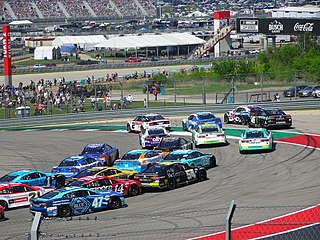
Auto racing is a motorsport involving the racing of automobiles for competition.

Stock car racing is a form of automobile racing run on oval tracks and road courses measuring approximately 0.25 to 2.66 miles. It originally used production-model cars, hence the name "stock car", but is now run using cars specifically built for racing. It originated in the southern United States; its largest governing body is NASCAR. Its NASCAR Cup Series is the premier top-level series of professional stock car racing. Australia, Canada, New Zealand, Mexico, Brazil and the United Kingdom also have forms of stock car racing. Top-level races typically range between 200 and 600 miles in length.

The Henry Ford Company was an automobile manufacturer active from 1901 to 1902. Named for Henry Ford, it was his second company after the Detroit Automobile Company, which had been founded in 1899. The Henry Ford Company was founded November 1901 from the reorganization of the Detroit Automobile Company. The company, much like the Detroit Automobile Company, was plagued by disputes between Ford and his investors, and Ford left in 1902. Later that year, the company was reorganized as the Cadillac Automobile Company under the suggestion of Henry M. Leland. Cadillac, whose early vehicles were identical in design to those of Ford's later Ford Motor Company except for the engine, would develop a reputation for precision engineering and was acquired by the nascent General Motors (GM) in 1909, becoming GM's luxury marque. Ford would eventually find success with the Ford Motor Company, and is considered one of the primary pioneers of the automobile.
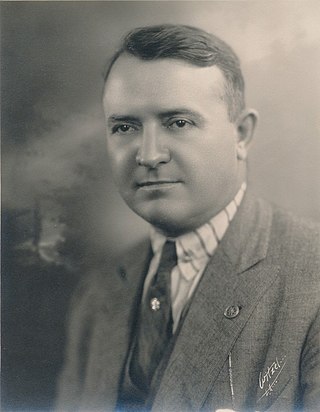
Berna Eli "Barney" Oldfield was an American pioneer automobile racer; his "name was synonymous with speed in the first two decades of the 20th century".
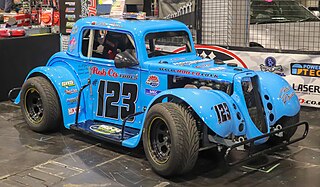
Legends car racing is a style of auto racing designed primarily to promote exciting racing and to keep costs down. The race car bodyshells are 5/8-scale replicas of American automobiles from the 1930s and 1940s, powered by Yamaha XJ1250, FJ1200 or, starting in 2018, FZ09 (water-cooled) engines. The worldwide sanctioning body for legends car racing is INEX.
Dirt track racing is a form of motorsport held on clay or dirt surfaced oval race tracks often used for thoroughbred horse racing. Dirt track racing started in the United States before World War I and became widespread during the 1920s and 1930s using both automobiles and motorcycles. Two different types of race cars dominate — open wheel racers in the Northeast and West and stock cars in the Midwest and South. While open wheel race cars are purpose-built racing vehicles, stock cars can be either purpose-built race cars or street vehicles that have been modified to varying degrees. There are hundreds of local and regional racetracks throughout the nation. The sport is also popular in Australia, New Zealand, Canada, South Africa and the United Kingdom.
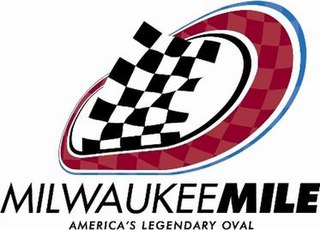
The Milwaukee Mile is a 1.015 mi (1.633 km) oval race track in the central United States, located on the grounds of the Wisconsin State Fair Park in West Allis, Wisconsin, a suburb west of Milwaukee. Its grandstand and bleachers seats approximately 37,000 spectators. Paved 69 years ago in 1954, it was originally a dirt track. In addition to the oval, there is a 0.8 mi (1.3 km) road circuit located on the infield.
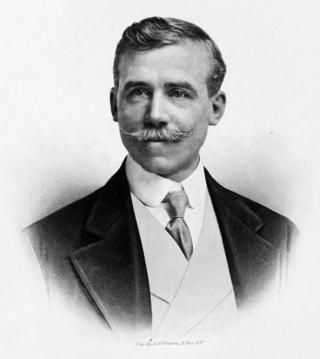
Alexander Winton was a Scottish-American bicycle, automobile, and diesel engine designer and inventor, as well as a businessman and racecar driver. Winton founded the Winton Motor Carriage Company in 1897 in Cleveland, Ohio, making the city an important hub of early automotive manufacturing. His pioneering achievements in the automotive industry included taking one of the first long-distance journeys in America by car and developing one of the first commercial diesel engines. Winton left the automotive manufacturing business when he liquidated his car company in 1924 to focus on his powertrain engineering firm, Winton Gas Engine & Mfg. Co., which he had established twelve years earlier to focus on engine development. This business was sold to General Motors in 1930 and became the Cleveland Diesel Engine Division. Winton died in 1932 and is interred in Lake View Cemetery in Cleveland.

Ford Performance is the high-performance division of the Ford Motor Company and the multinational name used for its motorsport and racing activity.

William Ernest Metzger was an automotive pioneer and salesman from Detroit. He opened one of the first automobile dealerships in the United States, and participated in the early development of a number of early automobile companies, including the Cadillac Automobile Company and the E-M-F Company, in which the "M" stands for his name.

Tom Cooper was an American cyclist and early automobile racing driver. He is best known for his rivalry with cyclist Major Taylor, as well as his later work with Henry Ford and Barney Oldfield.
Wilbur Rakestraw was an American racing car driver. He was born in Dallas, Georgia, into a family of racers. His career included racing in the SRE organization as well as the 11 NASCAR Grand National Series and 30 Convertible races. Rakestraw was known for his toughness and thoughtfulness of other drivers due to one incident at Lakewood Speedway in 1957 when he drove through a fence and into the infield lake to avoid T-boning another driver who had crashed in front of him. After he retired from racing, Rakestraw went to work as a mechanic and later became a service manager for a local grading company.

The Auto Union Grand Prix racing cars types A to D were developed and built by a specialist racing department of Auto Union's Horch works in Zwickau, Germany, between 1933 and 1939, after the company bought a design by Dr. Ferdinand Porsche in 1933. The Auto Union type B streamlined body was designed by Paul Jaray.

The First Auto is a 1927 American drama film directed by Roy Del Ruth about the transition from horses to cars and the rift it causes in one family. It stars Charles Emmett Mack and Patsy Ruth Miller, with Barney Oldfield having a guest role in the movie. While mainly a silent film, it does have a Vitaphone sound-on-disc soundtrack with a synchronized musical score and sound effects, as well as some spoken words, cheering, and laughter. As of January 1st, 2023, the film is now in the public domain.

The American stock car racing category NASCAR raced in Australia from the late 1980s to the early 2000s. After strong initial interest, particularly in Melbourne at Australia's only purpose-built NASCAR style paved oval speedway, the Calder Park Thunderdome, the category collapsed in the early 2000s and has defied several attempts to revive it since then.

The 2013 Mudsummer Classic was a NASCAR Camping World Truck Series stock car race held on July 24, 2013, at Eldora Speedway in New Weston, Ohio. The race was the first dirt track race held by a NASCAR national touring series since 1970. Contested over 150 laps, the race was the tenth of the 2013 NASCAR Camping World Truck Series season. Ken Schrader of self-owned Ken Schrader Racing won the pole position, and became the oldest pole sitter in NASCAR history at 58 years of age. Austin Dillon of Richard Childress Racing won the race, while Kyle Larson and Ryan Newman finished second and third, respectively.

The NASCAR Cup Series is the top racing series of the National Association for Stock Car Auto Racing (NASCAR). The series began in 1949 as the 'Strictly Stock Division', and from 1950 to 1970 it was known as the 'Grand National Division.' In 1971, when the series began leasing its naming rights to the R. J. Reynolds Tobacco Company, it was referred to as the 'NASCAR Winston Cup Series' (1971–2003). A similar deal was made with Nextel in 2003, and it became the 'NASCAR Nextel Cup Series' (2004–2007). Sprint acquired Nextel in 2005, and in 2008 the series was renamed the 'NASCAR Sprint Cup Series' (2008–2016). In December 2016, it was announced that Monster Energy would become the new title sponsor, and the series was renamed the 'Monster Energy NASCAR Cup Series' (2017–2019). In 2019, NASCAR rejected Monster's offer to extend the current naming rights deal beyond the end of the season. NASCAR subsequently announced its move to a new tiered sponsorship model beginning with the 2020 season similar to other US based professional sports leagues, where it was simply known as the 'NASCAR Cup Series', with the sponsors of the series being called Premier Partners. The four Premier Partners are Busch Beer, Coca-Cola, GEICO, and Xfinity.

The 2018 Ford EcoBoost 400 was a Monster Energy NASCAR Cup Series race that was held on November 18, 2018, at Homestead-Miami Speedway in Homestead, Florida. Contested over 267 laps on the 1.5 mile (2.4 km) oval, it was the 36th and final race of the 2018 Monster Energy NASCAR Cup Series season, and was also the last race for the Ford Fusion, as it will be replaced for the 2019 season by the Mustang GT. This race was the final start for Furniture Row Racing and BK Racing.

The 2019 First Data 500 was a Monster Energy NASCAR Cup Series race held on October 27, 2019, at Martinsville Speedway in Ridgeway, Virginia. Contested over 500 laps on the .526 mile (.847 km) short track, it was the 33rd race of the 2019 Monster Energy NASCAR Cup Series season, seventh race of the Playoffs, and first race of the Round of 8.
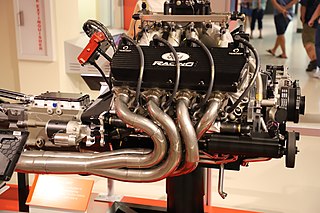
NASCAR, the highest governing body and top level division for stock car racing in the United States, has used a range of different types of engine configurations and displacements since its inaugural season in 1949. The engines are currently used in the Cup Series, Xfinity Series, Camping World Truck Series, and the Whelen Modified Tour.


















